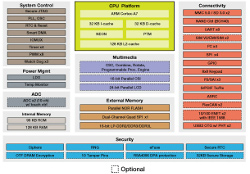Wireless enabled SODIMM-style COM debuts new i.MX6 ULL SoC
Mar 28, 2017 — by Eric Brown 1,024 views [Updated: Jan. 31, 2018] — Toradex is shipping the Linux-driven “Colibri iMX6ULL,” one of the first modules to adopt NXP’s new, power- and cost-optimized “i.MX6 ULL” SoC. The new Colibri module also features dual-band WiFi-ac and BT 4.2/BLE wireless and industrial temperature support.
[Updated: Jan. 31, 2018] — Toradex is shipping the Linux-driven “Colibri iMX6ULL,” one of the first modules to adopt NXP’s new, power- and cost-optimized “i.MX6 ULL” SoC. The new Colibri module also features dual-band WiFi-ac and BT 4.2/BLE wireless and industrial temperature support.
Toradex announced the “Colibri iMX6ULL” computer-on-module at Embedded World on Mar. 28, 2017. As implied by its name, this new member of Toradex’s 67.6 x 36.7mm Colibri COM family integrates NXP’s recently announced i.MX6 ULL SoC, an ultra-low power variant of NXP’s ubiquitous i.MX6. The new COM is also Toradex’s first Colibri module to include onboard wireless. (See Colibri iMX6ULL details farther below.)
Introducing the NXP i.MX6 ULL SoC
— ADVERTISEMENT —
When NXP announced the i.MX6 ULL SoC in September of 2016, it offered few hints as to how it differs from the i.MX6 UL. NXP did, however, suggest it was more affordable, starting at $3.50 USD in 10,000 unit quantities.


Comparison of NXP i.MX6 ULL (left) and i.MX6 UL SoC block diagrams
(click images to enlarge)
New features in the i.MX6 ULL relative to the i.MX6 UL include ESAI multi-channel audio I/O, and a 24-bit (rather 16-bit) CSI interface. In addition, the UL’s EMV SIM module for cellular radio expansion has been removed. Optional features in the ULL have expanded beyond the UL’s ADC interfaces and multimedia engine, to include 10/100 Ethernet and FlexCAN. The ULL also adds an EPD/PXP interface for aimed at the e-reader market.

(click image to enlarge)
Both the UL and ULL provide new security, tamper detection, and power management features not found on earlier i.MX6 models, with the ULL offering more highly optimized low-power modes than those of the UL. While the ULL continues to offer core security features like the secure boot, hardware cryptographic cipher engines, and random number generators, it removes those UL security features focused on POS applications, including CAAM/BEE/DryICE. And like the UL, the ULL offers a stripped down but still 3D-capable WXGA display interface, compared to the more powerful Vivante GPUs of the earlier i.MX6 SoCs. Additional insight into the differences appears in this i.MX 6ULL Migration Guide (PDF).
Colibri iMX6ULL module details — (updated Jan. 31, 2018)
The Colibri iMX6ULL is the first of member of Toradex’s 67.6 x 36.7mm COM to use NXP’s new i.MX6 ULL SoC, as well as the first Colibri module to include onboard wireless. It follows the i.MX6 based Colibri i.MX6, among other Toradex Colibri modules.


Collibri iMX6ULL front (left) and back views
(click images to enlarge)
Toradex is offering the Colibri iMX6ULL in two standard SKUs: an 800MHz-clocked board with 512MB DDR3L SDRAM and 512MB SLC flash memory; and a lower-end, 528MHz-clocked model with 256MB RAM and 128MB flash. Additionally, the first of these includes an onboard wireless subsystem (Wi2wi’s WM828CC6) that supports Bluetooth 4.2 with BLE, plus dual-band WiFi 802.11 ac/a/b/g/n with up to 300Mbits/s transfer speeds and simultaneous station and access point modes.

Colibri iMX6ULL block diagram
(click image to enlarge)
Other features common to both Colibri iMX6ULL models include USB host and OTG ports, a 10/100 Ethernet controller with support for up to two interfaces, SDIO/SD/MMC, a 24-bit RGB LCD interface with 4-wire resistive touch, a serial camera interface, and stereo digital audio.
 Colibri Eval Board |
The Colibri iMX6ULL is further equipped with an extensive set of SDIO, I2C, SPI, UART, PWM, and CAN interfaces, as indicated in the block diagram above. The 67.6 x 36.7 x 6.2mm module is available in 0 to 70°C and -40 to 85°C versions, and offers minimal availability through 2028.
The module ships with NXP’s Yocto Project based Linux distribution. Five carrier board options are available: the Colibri Evaluation Board, as well as the Iris, Orchid, Viola, and Aster Carrier Boards. A variety of optional touch and non-touch displays are also available.
Further information
The Colibri iMX6ULL is shipping now, priced in low volumes (1-99 units) at $44.75 (with 256MB/128MB RAM/flash) and $86.60 (512MB/512MB RAM/flash + wireless). More details are available at Toradex’s Colibri iMX6ULL product page.
Note: This post is an updated version of our coverage of Toradex’s March 2017 Colibri iMX6ULL pre-announcement, with additional reporting by Rick Lehrbaum.

Please comment here...